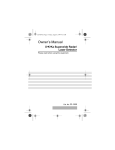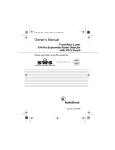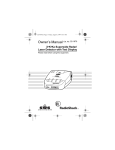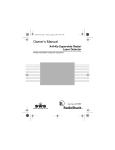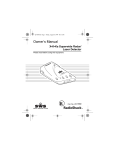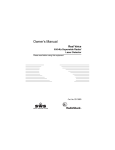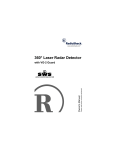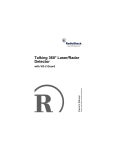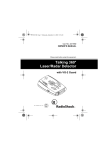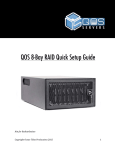Download Radio Shack XoKoKa Superwide Owner`s manual
Transcript
22-1664.fm Page 1 Friday, August 6, 1999 9:44 AM Owner’s Manual X•K•Ka Superwide Radar/Laser Detector Please read before using this equipment. Cat. No. 22-1664 22-1664.fm Page 2 Friday, August 6, 1999 9:44 AM FEATURES Your RadioShack X•K•Ka Superwide Radar/Laser Detector receives all X-, K-, and Ka-band traffic radar signals and also detects both the instant-on and laser systems many police departments now use to measure vehicle speed. When it detects a signal, your easy-tomount detector alerts you with a light and/or a tone, which increase in speed as the signal gets stronger. Your detector’s safety alert feature gives you advance warning of potential road hazards by detecting signals from transmitters that broadcast special safety alerts. Your detector also has FAST® (False Alert Suppression Technology) circuitry that helps prevent false alarms caused by signals from other radar detectors, without reducing your detector’s sensitivity to traffic radar signals. Note: Some areas have laws regulating the use of radar detectors. Check with your local law enforcement agency about the laws in your area. We recommend you record your detector’s serial number here. The serial number is located on the detector’s bottom panel. Serial Number: ______________________________ 1996 Tandy Corporation. All Rights Reserved. RadioShack is a trademark used by Tandy Corporation. Safety Alert is a trademark of Cobra Electronics. FAST is a registered trademark used by Tandy Corporation. InstaClear is a registered trademark used by Ford Motor Company. ElectriClear is a registered trademark used by Libbey, Owens, Ford, and Delco-Remy. 2 22-1664.fm Page 3 Friday, August 6, 1999 9:44 AM Your detector has many useful features, including: X-, K-, Ka-Band, and Laser Signal Detection — warns you when the detector detects signals from traffic radar or laser devices. Different tones sound (for each radar signal type) and different indicators flash (for radar or laser devices), to let you know the type of signal received. City/Highway Modes — let you reduce the detector’s sensitivity to weak X-, K-, and Ka-band signals, without affecting the detector’s sensitivity to laser signals while you are in the city. Safety Alert Signal Detection — warns you when the detector detects signals broadcast by safety alert transmitters. Some public safety and government agencies install these transmitters in some emergency vehicles and near some known road hazards and construction areas, to provide advance warning of potentially hazardous situations. 3 22-1664.fm Page 4 Friday, August 6, 1999 9:44 AM Your detector includes the following items: • Hook-and-loop tape • Sun visor clip • Power cord 4 22-1664.fm Page 5 Friday, August 6, 1999 9:44 AM CONTENTS A Look at the Detector . . . . . . . . . . . . . . . . . . . . . . . 6 Installation. . . . . . . . . . . . . . . . . . . . . . . . . . . . . . . . . 7 Mounting Guidelines. . . . . . . . . . . . . . . . . . . . . . . 7 Hook-and-Loop Mounting . . . . . . . . . . . . . . . . 8 Visor Mounting . . . . . . . . . . . . . . . . . . . . . . . . 9 Windshield Mounting . . . . . . . . . . . . . . . . . . 10 Connecting Power . . . . . . . . . . . . . . . . . . . . . . . 11 Operation. . . . . . . . . . . . . . . . . . . . . . . . . . . . . . . . . 12 Turning the Detector On and Off . . . . . . . . . . . . 12 Adjusting the Volume . . . . . . . . . . . . . . . . . . . . . 12 Selecting the City and Highway Modes . . . . . . . 13 Receiving and Identifying Radar, Laser, and Safety Alert Signals . . . . . . . . . . . . . . . . . . 14 Troubleshooting . . . . . . . . . . . . . . . . . . . . . . . . . . . 15 Care and Maintenance . . . . . . . . . . . . . . . . . . . . . . 17 Replacing the Fuse . . . . . . . . . . . . . . . . . . . . . . 18 5 22-1664.fm Page 6 Friday, August 6, 1999 9:44 AM A LOOK AT THE DETECTOR OFF/VOLUME Control — turns the detector on and off and lets you adjust the volume. POWER Indicator — lights when you connect the detector to power and turn it on. R (Radar) Indicator — flashes when the detector detects X-, K-, or Ka-band radar signals. L (Laser) Indicator — flashes when the detector detects a traffic laser signal. CITY/HAZARD Indicator — lights when the detector is in the city mode and flashes when it detects a safety alert signal. CITY/HIGHWAY Button — switches between the city and highway modes. DC 12V Jack — the power cable plugs in here. Laser Detection Lens — receives incoming laser signals. 6 22-1664.fm Page 7 Friday, August 6, 1999 9:44 AM INSTALLATION MOUNTING GUIDELINES For the best performance, select a location for the detector where it has a direct view of the road. The detector’s radar antenna and laser detection lens are at the opposite end from the display and controls. Follow these guidelines when you select a mounting location. • Choose a location that does not block the driver’s vision. • Mount the detector in a level position. • Since signals are blocked by metal surfaces, the detector’s view of the road must not be blocked. • Some vehicles have InstaClear® or ElectriClear® defogging windshields, which have metal coatings that block signals. General Motor’s APV vans have a solar shield that keeps the vehicle cooler during the summer. This shield also blocks signals. A detector installed in a vehicle with any of these features will probably not detect a signal. 7 22-1664.fm Page 8 Friday, August 6, 1999 9:44 AM • Since window tinting reduces the received strength of laser signals, you should not mount the detector behind any tinted glass. • Do not mount the detector where the driver or a passenger might hit it in a sudden stop or accident. Caution: Whichever mounting method you choose, place the detector out of view when you leave the vehicle. This keeps the detector out of sight of thieves and prevents exposing it to extremely high temperatures, which can temporarily impair your detector’s performance. Hook-and-Loop Mounting For some dashboards, the hook-and-loop tape supplied with your detector might be best for mounting. Follow these steps to use the hook-and-loop tape. 1. Use a damp cloth to thoroughly clean the bottom of the detector and the dashboard. Let both surfaces dry completely. Note: The tape’s adhesive might not stick to a surface treated with vinyl cleaner or protectant. 2. Peel off the tape’s paper backing and apply the tape to the bottom of your detector. 8 22-1664.fm Page 9 Friday, August 6, 1999 9:44 AM Notes: • If you are mounting the detector on a curved dashboard, you might need to cut the hook-andloop tape in half and use one strip on each side of the bottom of the detector. • Do not place the hook-and-loop tape over the detector’s serial number. 3. Remove the paper backing from the other side of the tape and press your detector onto the dashboard. Visor Mounting The supplied sun visor clip lets you quickly mount the detector on your vehicle’s sun visor. Warning: Do not mount the detector on a visor if this places the detector near the driver’s or a passenger’s head. 9 22-1664.fm Page 10 Friday, August 6, 1999 9:44 AM Follow these steps to use the sun visor clip. 1. Slide the sun visor clip into the slot on top of the detector. 2. Clip the detector over the back of your vehicle’s sun visor so you can see the detector’s display. If you later want to use another method of mounting the detector, remove the sun visor clip by simply pulling it out of the detector. Windshield Mounting You can mount the detector on your vehicle’s windshield using a windshield radar detector mount such as RadioShack Cat. No. 270-034 (not supplied). Follow the instructions provided with the mount to mount the detector on your windshield. 10 22-1664.fm Page 11 Friday, August 6, 1999 9:44 AM CONNECTING POWER Plug the supplied power cord’s barrel plug into the DC 12V jack on the side of the detector, then plug the power cord’s cigarette lighter plug into your vehicle’s cigarette-lighter socket. Caution: Before plugging the power cord’s cigarette lighter plug into your vehicle’s cigarette-lighter socket, make sure the knurled ring on the plug is screwed firmly onto the plug. See “Replacing the Fuse” on Page 18 for more information about the cigarette lighter plug. Note: If the detector does not operate when you turn it on, unplug the power cord from your vehicle’s cigarettelighter socket and carefully check the socket for debris. Also, check the fuse in the power cord and your vehicle’s fuse block (see “Replacing the Fuse” on Page 18). Caution: Unplug the power cord from your vehicle’s cigarette-lighter socket when you turn off the ignition. This prevents your vehicle’s battery from being drained if you leave the detector on when you turn off the ignition. 11 22-1664.fm Page 12 Friday, August 6, 1999 9:44 AM OPERATION TURNING THE DETECTOR ON AND OFF To turn on the detector, turn OFF/VOLUME away from you until it clicks. The detector sounds a distinctive tone for each band as a self test. Then all indicators turn off, except the POWER indicator. To turn off the detector, turn OFF/VOLUME toward you until it clicks and all indicators turn off. ADJUSTING THE VOLUME Turn OFF/VOLUME away from you to increase the detector’s volume. Turn OFF/VOLUME toward you to reduce it. 12 22-1664.fm Page 13 Friday, August 6, 1999 9:44 AM SELECTING THE CITY AND HIGHWAY MODES Your detector has two operating modes: city and highway. In the city mode, the detector requires a stronger X-, K-, or Ka-band signal before it sounds or displays an alert. This eliminates responses to most false sources, such as automatic door openers and alarm systems. Note: The city mode has no effect on laser alerts. The highway mode provides maximum sensitivity for open-road driving. To select the city mode, press CITY/HIGHWAY until the CITY/HAZARD indicator turns on. To select the highway mode, press CITY/HIGHWAY until the CITY/HAZARD indicator turns off. 13 22-1664.fm Page 14 Friday, August 6, 1999 9:44 AM RECEIVING AND IDENTIFYING RADAR, LASER, AND SAFETY ALERT SIGNALS When your detector senses a radar, laser, or safety alert signal, it responds with both audible and visual alarms. The detector notifies you of the type of signal by using different audio alarms for each radar type and a different visual alarm for either a radar or laser device. The detector also indicates the signal strength by increasing the rate at which it flashes the indicator and sounds the tone. When your detector senses a safety alert transmission, the CITY/HAZARD indicator flashes and the detector sounds a unique audio alarm. When your detector senses a traffic laser, the L indicator turns on and the detector sounds a continuous alert. When your detector senses instant-on radar, it sounds three beeps three times in 2 seconds. Then the detector sounds continuous beeps until you pass the radar source. Note: The instant-on radar detection circuit operates in both the city and highway modes. 14 22-1664.fm Page 15 Friday, August 6, 1999 9:44 AM TROUBLESHOOTING If you have problems operating your detector, the suggestions in this section might help. If you cannot solve the problem after trying these suggestions, take your detector to your local RadioShack store for assistance. If the detector does not turn on: • Be sure all power connections are secure. • Check the fuse that controls power to your vehicle’s cigarette-lighter socket. See your vehicle’s owner’s manual. • Check the fuse in the power cord’s cigarette-lighter plug. See “Replacing the Fuse” on Page 18. • The cigarette-lighter socket might be dirty. Clean it with fine emery cloth to ensure a good, clean connection. Caution: Do not place any metal object other than the cigarette lighter or a cigarette-lighter plug in the cigarette-lighter socket. Doing so could blow a fuse in your vehicle or cause the metal object to become very hot. If the detector gives a false alert when you use vehicle accessories such as power windows, motorized mirrors, brakes, and so on: • Check the vehicle’s electrical system for loose connections, including the main battery cable and alternator connections. 15 22-1664.fm Page 16 Friday, August 6, 1999 9:44 AM • Install a filter capacitor (1000 µf, 35 volts, such as Cat. No. 272-1032) on the back of the cigarettelighter socket, across the power connections. If the detector performs the self-test, but does not respond to radar signals when you see a police car: • A police car might not be equipped with radar (see the separate booklet Questions and Answers About Vehicle Speed Detection). • Police might be using VASCAR-type speed detection (see the separate booklet Questions and Answers About Vehicle Speed Detection). If the detector has poor laser detection range: • Be sure the laser detection lens is not blocked. • Be sure the detector is properly mounted. See “Mounting Guidelines” on Page 7. • Use lens-cleaning solution to clean the laser detection lens. 16 22-1664.fm Page 17 Friday, August 6, 1999 9:44 AM CARE AND MAINTENANCE Your RadioShack X•K•Ka Superwide Radar/Laser Detector is an example of superior design and craftsmanship. The following suggestions will help you care for the detector so you can enjoy it for years. Keep the detector dry. If it gets wet, wipe it dry immediately. Liquids can contain minerals that can corrode the electronic circuits. Handle the detector gently and carefully. Dropping it can damage circuit boards and cases, and can cause the detector to work improperly. Keep the detector away from dust and dirt, which can cause premature wear of parts. CLEANER Wipe the detector with a damp cloth occasionally to keep it looking new. Do not use harsh chemicals, cleaning solvents, or strong detergents to clean it. Modifying or tampering with the detector’s internal components can cause a malfunction and might invalidate its warranty. If your detector is not operating as it should, take it to your local RadioShack store for assistance. 17 22-1664.fm Page 18 Friday, August 6, 1999 9:44 AM REPLACING THE FUSE If the detector stops operating, follow these steps to check the fuse in the power cord’s cigarette-lighter plug and replace the fuse, if necessary. 1. Carefully turn the knurled ring on the cigarettelighter plug counterclockwise to unscrew it. Caution: If you must use pliers to loosen the ring, be careful not to crush the ring or the metal tip inside the ring. 2. Carefully remove the ring and tip from the cigarettelighter plug, then remove the old fuse. Note: Take care not to lose the ring or tip, or the spring inside the plug. 3. Check the fuse. If it has blown, replace it with a 2amp, 11/4 × 1/4, fast-acting fuse (Cat. No. 270-1007). Caution: Using a fuse that does not meet these ratings or defeating the fuse protection can damage your detector, the power cable, or the vehicle’s electrical system. 18 22-1664.fm Page 19 Friday, August 6, 1999 9:44 AM 4. Replace the metal tip inside the ring, then place the fuse inside the cigarette-lighter plug and screw the ring back onto the plug. Make sure the tip is visible when you reassemble the cigarette-lighter plug. Caution: Never use pliers or other tools to retighten the ring on the cigarette-lighter plug. 19 22-1664.fm Page 20 Friday, August 6, 1999 9:44 AM RadioShack Limited Warranty This product is warranted against defects for 1 year from date of purchase from RadioShack company-owned stores and authorized RadioShack franchisees and dealers. Within this period, we will repair it without charge for parts and labor. Simply bring your RadioShack sales slip as proof of purchase date to any RadioShack store. Warranty does not cover transportation costs. Nor does it cover a product subjected to misuse or accidental damage. EXCEPT AS PROVIDED HEREIN, RadioShack MAKES NO EXPRESS WARRANTIES AND ANY IMPLIED WARRANTIES ARE LIMITED IN DURATION TO THE DURATION OF THE WRITTEN LIMITED WARRANTIES CONTAINED HEREIN. Some states do not permit limitation or exclusion of implied warranties; therefore, the aforesaid limitation(s) or exclusion(s) may not apply to the purchaser. This warranty gives you specific legal rights and you may also have other rights which vary from state to state. We Service What We Sell 10/95 RadioShack A Division of Tandy Corporation Fort Worth, Texas 76102 3A6 Printed in the Philippines




















